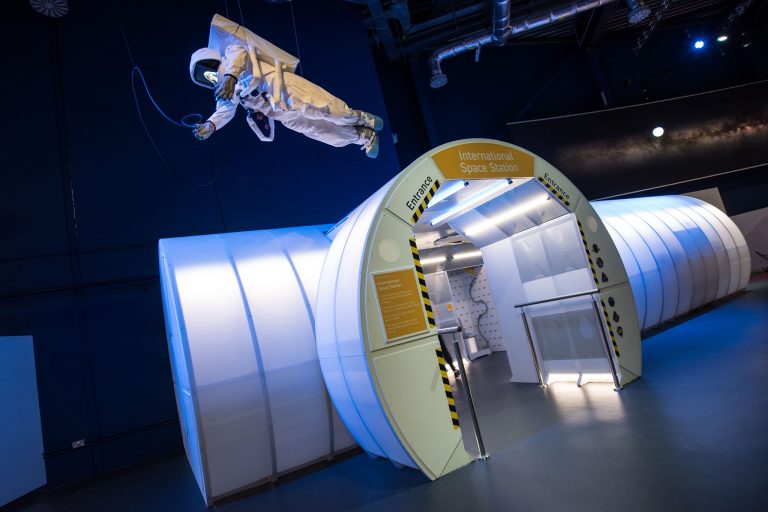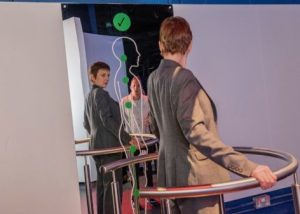
Photo: Life Science Centre Newcastle
The Space Zone, a new space exhibition that features research from Northumbria University launched earlier this month at Newcastle’s Life Science Centre.
Officially launched by Helen Sharman OBE, Britain’s first astronaut, earlier this month, Space Zone brings space exploration to life.
The permanent exhibition invites visitors to launch their own rockets, climb inside a mock-up model of part of the International Space Station, touch a genuine Moon rock and watch informative shows on a digital globe.
Guests can also discover how we’re already using space technology in our everyday lives – and learn how the future of space exploration is being shaped in the North East.
Development of the new attraction at the Life Science Centre has involved more than 150 scientists, engineers and space experts, including several academics from Northumbria University’s Department of Sport, Exercise and Rehabilitation.

Helen Sharman, Britain’s first astronaut, on Astronaut Rehab’s BOSU balance ball. Image: Northumbria University
Astronaut Rehab is an area of Space Zone that show cases the human spaceflight research conducted in Northumbria’s Aerospace Medicine and Rehabilitation (AMR) Laboratory that is led by Professor Nick Caplan. The AMR Lab has become a world leader the field of spinal changes and back pain rehabilitation in astronauts. This has been driven by Professor Caplan’s growing research team including Dr Andrew Winnard, Dr Enrico De Martino and PhD students Kirsty Lindsay, Jonathan Laws and Patrick Swain.
A fully interactive display, Astronaut Rehab includes three exhibits: a BOSU balance ball, a core strength challenge and a specially created museum-friendly version of the Functional Re-adaptive Exercise Device (FRED).
FRED is an anti-gravity exercise device designed to train the muscles that help control a stable spine and pelvis during all types of normal daily movements. Astronauts often require rehabilitation for these muscles after space missions.
Dr Andrew Winnard, Lecturer in Musculoskeletal Biomechanics and lead of the Aerospace Medicine Systematic Group within the wider AMR Lab, provided consultation for the Astronaut Rehab installation. Dr Winnard explains: “While in space, astronauts float in microgravity for several months, not needing to use their postural muscles, which become smaller and weaker. This can lead to back pain and risks of prolapsed discs when they return to Earth and have to stand upright against gravity again.
“The idea of the Astronaut Rehab area is to help people understand the technology and techniques developed around space medicine and astronaut health and to show how it can help improve medical practice on Earth for everyone.”
Other academics from the University’s departments of Mathematics, Physics and Electrical Engineering, Computer and Information Sciences and Northumbria Law School also contributed to the new Space Zone exhibition.
Dr Chris Newman, Professor in Space Law at Northumbria, was a member of the advisory group who consulted on the project, sharing their expertise and ideas.
At the launch event, Linda Conlon, Chief Executive of Life, said: “There is an enormous variety of space careers in the UK and one of the main purposes of our exhibition is to get young people thinking about how they might aspire to be part of that.
“We have our fair share of challenges in the region, with lower levels of attainment in science than national average. Life is also situated very close to some areas of extreme social deprivation where kids don’t think that science is for them, let alone a career linked to something as exciting as space science. So, we have a big job to do, and this new Space Zone is going to help us do it.”
Helping to tackle the misconceptions surrounding space careers, the exhibition includes role models of people who do work in this field, including PhD student Kirsty Lindsay, who features as a great example of females working in STEM and human spaceflight at Northumbria.
• Newcastle’s Life Science Centre is online at www.life.org.uk
• Find out more about Northumbria University’s Aerospace Medicine and Rehabilitation Laboratory
• Helen Sharman OBE is online at www.helensharman.uk
The founder of downthetubes, which he established in 1998. John works as a comics and magazine editor, writer, and on promotional work for the Lakes International Comic Art Festival. He is currently editor of Star Trek Explorer, published by Titan – his third tour of duty on the title originally titled Star Trek Magazine.
Working in British comics publishing since the 1980s, his credits include editor of titles such as Doctor Who Magazine, Babylon 5 Magazine, and more. He also edited the comics anthology STRIP Magazine and edited several audio comics for ROK Comics. He has also edited several comic collections, including volumes of “Charley’s War” and “Dan Dare”.
He’s the writer of “Pilgrim: Secrets and Lies” for B7 Comics; “Crucible”, a creator-owned project with 2000AD artist Smuzz; and “Death Duty” and “Skow Dogs” with Dave Hailwood.
Categories: downthetubes News, Events, Exhibitions
 Make Mine Manga exhibition heads to Greece
Make Mine Manga exhibition heads to Greece  Brighton gets set to host a Beach Tinted Zine Spectacular
Brighton gets set to host a Beach Tinted Zine Spectacular  The countdown to Portsmouth Comic Con 2024 is on
The countdown to Portsmouth Comic Con 2024 is on  Edward Taylor wins Embassy of Japan’s 17th Manga Jiman competition
Edward Taylor wins Embassy of Japan’s 17th Manga Jiman competition